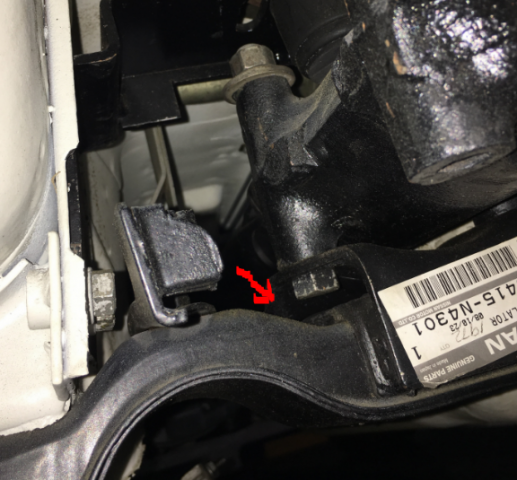
NewZed
Members-
Posts
6700 -
Joined
-
Last visited
-
Days Won
72
Content Type
Profiles
Forums
Blogs
Events
Gallery
Downloads
Store
Everything posted by NewZed
-
The bushings on the diff are mainly to avoid or remove the "clunk" during shifting that is common from a loose diff mount. The ES bushing has interlocking metal pieces inside so the bottom bump stop is not necessary. The original reason for RT to develop his modified mount was because he kept breaking the stock mount, behind a powerful small block chevy engine. It's actually "wrong" for an L6 application when used with the overhead GM mount because it lowers the diff nose compared to stock. It fixes the clunk but probably adds a little drive shaft vibration. When it's used with a bump stop on the top and the stock mount on the bottom it's essentially just a movement snubber, not really a "mount". The urethane bushings in the mustache bar also help with the clunk removal but are known to transmit diff noise in to the cabin. Many people go back to rubber due to the extra diff whine they hear after replacing the old worn out rubber. Beware. Many people go to polyurethane because it's cheaper than the stock rubber. There's no huge benefit, overall, to converting from rubber to polyurethane. You might consider evaluating each step individually before going crazy.
- 33 replies
-
JPN Garage Issues? Not answering emails and messenger
NewZed replied to Ryan Merrill's topic in Body Kits & Paint
Just for fun. Always intrigued by unsupported comments. https://www.instagram.com/jpngarage/?hl=en and the other links https://www.facebook.com/jpn.garage.inc/ http://jpngarage.com/ -
Rear Suspension Problem R200 in early Z with LS engine
NewZed replied to cbnow's topic in Gen III & IV Chevy V8Z Tech Board
No, if they're Tokico's they will fit. It's the gland nut that matters though, for the tube diameter. You were close. The point is, as stated, he might be able to make them work, depending on what he has now. Here's a good thread from another forum describing how Tokico used one shock across multiple platforms. http://www.classiczcars.com/topic/50654-are-tokicos-really-gone/ -
Rear Suspension Problem R200 in early Z with LS engine
NewZed replied to cbnow's topic in Gen III & IV Chevy V8Z Tech Board
Some inserts/shocks/struts/cartridges use a removable spacer on the end. You might be able to knock it off and have the right length. -
It's probably just a bump stop. The parts store usually have them in on the racks. They're typically used on the ends of old-timey traction bars. Here's some - https://www.amazon.com/s/ref=nb_sb_noss_2/166-8275892-3179244?url=search-alias%3Dautomotive&field-keywords=Energy+Suspension+bump+stop Here's the GM mount that goes on top of the diff, bolted to the RT mount. https://www.amazon.com/Energy-Suspension-3-1158G-Transmission-Mount/dp/B008SA69DG Summit links are getting redirected.
- 33 replies
-
Rear Suspension Problem R200 in early Z with LS engine
NewZed replied to cbnow's topic in Gen III & IV Chevy V8Z Tech Board
He could also cut the tubes down to 240Z length and move the spring perches, if he wants to keep the hubs and links. He'd have to find a way to rethread the top of the tube for the gland nut. Almost in to "coil-over" territory. He'd need the shorter shock/inserts also. -
Experiment - I'll type in the link address and see if it still gets changed by vigilink. www.summitracing.com Edit - it still changes to vigilink. So it's not a Paste thing. Must happen in between. That's the extent of my internet knowledge. Good luck SuperDan.
-
Clicking the Summit link still takes you to vigilink. If you go up to my post #3 and "copy link address" using a right-click, this is what you get when you paste it. So the vigilink redirect seems to be embedded in hybridz.org, disguised as summit.com. Must happen when it's pasted from outside. http://redirect.viglink.com/?format=go&jsonp=vglnk_148339678546515&key=f7179343930a8f28263c3ebbccb8a0a8&libId=ixgo325d0100guav000DA9f0ypd7v&loc=http%3A%2F%2Fforums.hybridz.org%2Ftopic%2F126603-site-redirecting-links-to-viglink%2F%23entry1184016&v=1&out=https%3A%2F%2Fwww.summitracing.com%2F&ref=http%3A%2F%2Fforums.hybridz.org%2Findex.php%3Fapp%3Dcore%26module%3Dsearch%26do%3Dactive%26search_app%3Dforums&title=Site%20redirecting%20links%20to%20VIGLINK%20-%20Site%20Support%20-%20HybridZ&txt=https%3A%2F%2Fwww.summitracing.com%2F Here's the summit link pasted from outside, again. https://www.summitracing.com/ Edit - just tried the newly pasted from outside Summit link and it still redirects. You've got some weird malware changing the content of the link as its pasted.
-
The high O2 and HC indicate a misfiring cylinder. Gasoilne (HC) and oxygen (O2) are passing through the misfire without catching fire and combining to form CO2 and H2O. Focus on spark, check valve lash.
-
72 z distributor way out of range
NewZed replied to hatepotholez's topic in Trouble Shooting / General Engine
You can't see the pedestal in either picture. The pictures aren't worth much, they don't tell anything. -
The stock factory mount on the crossmember is most likely right. The factory mustache bar is flexible and it's mounted with very flexible rubber bushings. You're replacing a bunch of sloppy flexible stuff with rigid parts. You could just slot those urethane bushings to make those parts work together. If the distances are correct, up and down, take a rat tail file and slot the holes to give the bolts room to let the nose move up.
- 28 replies
-
- differential
- rear suspension
-
(and 4 more)
Tagged with:
-
Don't overlook that one very important part of mounting the diff is that the angle of the diff's pinion shaft has to match the angle of the transmission's output shaft. So that the u-joints of the propeller shaft will be in-phase, to avoid vibration. You shouldn't be modifying anything until you know the angles are right. The T3 bar shouldn't change the angle of the diff if it's designed to work with the stock mount. And the Technoversion piece is well-known and seems to work well. And, since you're using the Technoversion piece with a stock mount, you shouldn't really be worrying about it. It's not really a mount the way that you're using it, it's just a snubber for the nose of the diff. You could remove it entirely while you figure out how to make the stock factory mount work. Then install the snubber.
- 28 replies
-
- differential
- rear suspension
-
(and 4 more)
Tagged with:
-
Could also be that the car has been in an accident. If you give the name of the company that made your front mount people could tell you if it should work with the T3 bar.
- 28 replies
-
- differential
- rear suspension
-
(and 4 more)
Tagged with:
-
I only see one shadowy picture of things that are hard to define. Bad picture and only one. I can tell that you don't have the crossmember installed though. That would be a good clue of how far off the front mount is. I attached a picture of a diff nose sitting in its stock mount (borrowed it from classiczcars.com). Notice how close it is to the crossmember. The rear bar and the front mount have to work together. Obviously one of your parts has to go. Pick one. You seem too attached to that front mount, like you don't want to give it up. Did you make it yourself? If the T3 bar is right then the front mount isn't. Pretty simple. Good luck.
- 28 replies
-
- differential
- rear suspension
-
(and 4 more)
Tagged with:
-
Sounds like you're trying to force together two aftermarket parts that aren't compatible. The aluminum bar was probably deigned for the factory front mount. What you're describing suggests that your aftermarket upper front mount is incorrect for the application. Is it so ugly that you can't show a picture? Might explain the situation.
- 28 replies
-
- differential
- rear suspension
-
(and 4 more)
Tagged with:
-
Way too low for what? It's still not clear what you're trying to mount the nose of the diff to. You said it was some sort of custom front diff mount. Could be that the flexibility of the stock bar just allowed you to use a "wrong" diff mount in the front.
- 28 replies
-
- differential
- rear suspension
-
(and 4 more)
Tagged with:
-
In the same vein as aarang's comment, learn what you have. Could just be cam timing holding your RPM down. And beware discounted parts. There are some shiny cool-looking parts out there that don't actually fit and work. The stock injection parts aren't really very expensive. And the turbo variant requires more than the NA design. You should get specs on all of your parts and go through the engine to be sure that they're installed correctly. Cam timing, ignition timing, etc. Measure cylinder pressure, check valve lash, examine spark plugs... Find out the specs on the cam. Know what you have.
-
240z Camshaft Oil Spray Bar AKA Tube Oil Cam 13100-E3004
NewZed replied to lim's topic in Parts Wanted
There's a thread on another forum about aftermarket bars. Here's some links from it if you get desperate. http://www.nissanpartsdeal.com/parts/nissan-tube-oil-cam~13100-e3004.html http://www.yoesheadporting.com/product-page/687b6dfd-1bc5-8b50-6674-2e4f8b055f90 http://www.datsunstore.com/oiler-7077-used-p-1429.html http://www.datsunstore.com/oiler-7077-billet-aluminum-p-1428.html -
Addressing firewall flex
NewZed replied to grannyknot's topic in Brakes, Wheels, Suspension and Chassis
Wouldn't there be force on the tower forward under braking? Levering around the TC rod? Just trying to wrap my head around it. Straight line pushing the wheel backward, but rotational pushing the top forward. You could imagine if the top of the strut was disconnected and you hit the brakes it would rotate around as the bottom of the tire is pushed backward. -
Sounds like you got lucky. As I recall Casey took people's money and manifolds but did not deliver a product or return what he took. That's called stealing and people that do that are called thieves. http://forums.hybridz.org/topic/117103-senza-pari-manifold-group-buy-v-20/?do=findComment&comment=1097597 If the manifold does the same job the stock one did, with no change in power output, then it's is essentially an appearance piece, as was suggested early on.
-
Your link doesn't work. And your comment is kind of meaningless since "works" doesn't tell anything. Beside that it's in the wrong sub-forum. Many would love to hear more details though if you want to do it right.
-
Seems like this might be your problem. If you have a factory stock rubber mount try that before swapping bars. And take some decent pictures of the front mount with light. Your pictures are terrible.
- 28 replies
-
- differential
- rear suspension
-
(and 4 more)
Tagged with:
-
What happens if you use the stock mustache bar with the Sti diff? That will tell you if it's the diff or the bar.
- 28 replies
-
- differential
- rear suspension
-
(and 4 more)
Tagged with:
-
Search "GM HEI module 240Z" for one. Or swap to the 280ZX distributor ("matchbox" in CM's post above). This link covers much of your problem - http://www.fivestarmanufacturing.com/kat_s
- 11 replies
-
- Compression
- oil pan heater
-
(and 1 more)
Tagged with:
-
New Spring option for the s30 240z
NewZed replied to Jazz86's topic in S30 Series - 240z, 260z, 280z
Is that an S30 or S130? Nothing wrong with exploring new possibilities. Here's a similar option using the Moog spring number for a Chevette. That option gets kicked around often for the S30's. http://forums.hybridz.org/topic/110278-need-stronger-front-coil-springs-for-240z/ Seems like people often leave spring preload out of their overall calculations. That determines the weight that the spring will hold up (depending on spring rate of course) before compressing. You can set ride height somewhat independently of rate using preload. Nissan uses a somewhat soft spring, but preloaded when installed. The tires are compressing along with the spring, when the suspension is in use. Lots to consider if you want to end up with a good ride after making your car look right.- 12 replies
-
- suspension
- s30
-
(and 3 more)
Tagged with:

